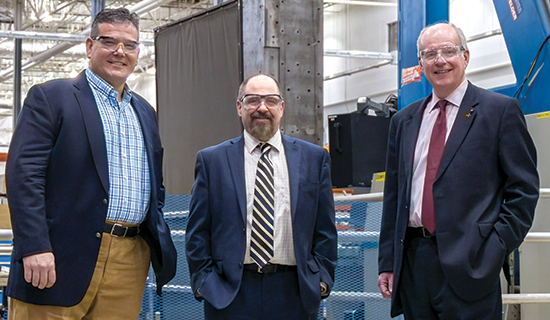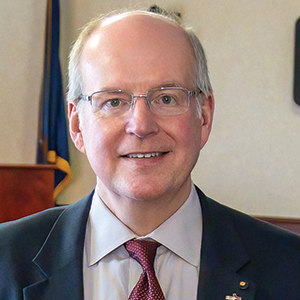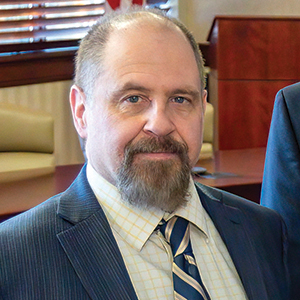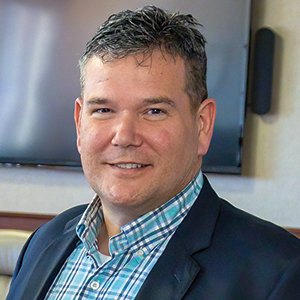Safeguarding American manufacturing, technology and national security are critical responsibilities, and those at Concurrent Technologies Corp. (CTC) — from the top leadership down — take that seriously.
Whether designing electric flightline generators for Air Force aircraft, developing small-caliber ammunition for the Army, or patenting a portable welding solution to repair Navy ships, CTC’s employees work together to make the world safer and more productive. To achieve this company vision, President and CEO Edward J. Sheehan Jr. takes an all-hands-on-deck approach.
“To serve the clients that have entrusted us with very significant challenges, we rely on a team of technical leaders, subject matter experts and support staff,” says Sheehan, who joined CTC in 2009 when the company’s first CEO retired. “Obviously, as a leader, you rely on other leaders to help. It’s certainly not just me.”
As an independent, nonprofit, applied scientific research and development (R&D) firm, CTC provides advanced manufacturing, information technology and readiness solutions to government agencies, as well as private sector clients. To help clients transition from R&D to production and commercialization, CTC also works closely with its wholly owned technology transition affiliate, Enterprise Ventures Corporation (EVC).
To solve complex problems together, these teams must maneuver strict industry regulations, exacting quality specifications and classified project clearance. Teamwork within and between both companies is essential. Here’s how CTC recruits, retains and engages this dedicated team of specialists to cohesively execute cutting-edge innovations.
Flattening the hierarchy
One of CTC’s strengths, Sheehan says, is its flat, matrix-based structure, in which employees report to both functional department heads and project managers, facilitating a horizontal flow of skills and information instead of operating under the traditional vertical hierarchy.
“When we develop solutions, we’ll pull in advanced materials scientists, we’ll pull in energy resiliency subject matter experts, we’ll pull in IT specialists who can help in all the aspects of the solution,” Sheehan says. “We’re able to do that pretty quickly and in a robust way … which allows for rapid decision-making and agility.”
This structure also gives employees direct access to the company’s Technical Advisory Board, which offers guidance based on its members’ experience in government enterprise and technology R&D.
“There has to be a great degree of trust to share different levels of the organization with the board,” Sheehan says. “Not every CEO is comfortable doing that, but the board provides an alternative view that’s very helpful to us.”
Sheehan and his team encourage collaboration across every level of the organization, with regular communication to keep everyone aligned.
“We really do a lot to communicate across all the teams … in the form of quarterly reviews and lunch-and-learn sessions,” says George W. Appley, executive vice president and COO.
The company also hosts townhalls where employees can ask questions.
“That goes a long way to keep us agile and to keep everybody informed of where the business is and what we’re doing,” says Appley.
The goal of these forums isn’t just to keep employees informed but also to foster trust, open communication and healthy debate.
“If we’re in a meeting and I say, ‘This is what I see,’ I want people at any level in the organization, if they disagree, to be able to say, ‘I don’t agree with that,’ and we’ll have a conversation,” Sheehan says. “We solicit that feedback to try to create an environment where people feel safe that they can ask a question or disagree, and they’re not going to be chastised.”
Instilling leadership
The oldest of five children, Sheehan displayed natural leadership attributes from a young age, as he “always responsible for the rest of the tribe,” he says. While some business leaders are seemingly born with these skills, he believes that others can hone these traits over time with proper training. With that approach, he grows the team at CTC through a combination of promoting from within and recruiting for specialized skills.
“You like to be able to promote from within,” Sheehan says. “That’s part of the attraction of joining a company, knowing that you can grow within the organization and assume a greater level of responsibility.”
CTC is constantly grooming employees to grow and develop, both personally and professionally, through technical training, industry certifications, trade conferences and other association involvements. An added benefit of promoting from within, Sheehan says, is that leaders who naturally rise through organization gain an ingrained understanding of the company’s culture, values and flat decision-making process.
By contrast, when the organization has to acquire specific skillsets through recruiting, it’s crucial to onboard those new leaders to the CTC way.
“When you do bring people in from the outside, it’s very important that we mentor those leaders, so they understand the attributes and culture of our organization,” Sheehan says. “The way we lead may be different than what they’ve experienced. As an example, if somebody comes from a military background, a lot of that structure is command-and-control. In our company, it’s different.”
Recruiting talent
While Sheehan works hard to retain employees and promote from within when possible — maintaining an attribution rate of only 9 percent — he also hires outside talent as the company continues to grow. In fiscal year 2021, CTC experienced 5 percent employee growth, bringing the team size to about 400.
Hiring can be particularly challenging for companies like CTC searching for specific technical skills.
“We’re not just looking for recent entry-level graduates,” Sheehan says. “We’re looking for people with technical experience, and for some of the work that we do for the government, they have to have clearances and pass certain tests. We often refer to them as unicorns; they’re very difficult to find and in high demand.”
To keep up with this growth in a challenging labor market, Sheehan reorganized the company’s approach to recruiting these unicorns.
“In the past, we accessed outside recruiting firms to help us identify candidates,” he says. “More recently, as the labor market was getting tighter and tighter and we had opportunities to grow, we felt like it would be a better decision to bring those resources in-house.”
Although CTC has always employed some internal recruiting staff, this department has grown to 20 full-time equivalents over the last year. Strengthening these capabilities in-house allows CTC to quickly find and hire candidates who match the company’s values and specific technical skills.
“We feel it’s really important that the recruiters understand what we do and have relationships with the hiring managers to more fully understand what we need,” Appley says.
Given the nature of CTC’s highly specialized business and the sheer breadth of the technology the company covers, recruiting is a challenge in and of itself, says Edward D. Peretin, president of CTC’s affiliate, Enterprise Ventures Corp.
“It forces us to pivot within HR to attract that talent set, and we’ve done a very good job of rising to the need,” he says.
CTC also offers bonuses for employee referrals that result in new hires. “We have great confidence and trust in our employees, and if they recommend some of their friends, we want our company to grow in that regard,” Sheehan says.
He says that, in today’s competitive marketplace, a referral can sometimes be the difference in a candidate’s employment decision.
Adapting to the environment
CTC’s approach to collaboration has shifted since COVID-19 restrictions limited in-person contact at the company’s 15 locations. To keep employees safe and productive during the peak of the pandemic, Sheehan gave the workforce more flexibility to work remotely.
But even before COVID-19 became a concern, 40 percent of CTC’s staff already worked remotely, either from home or from a client site. Still, some employees worried about working from home during the pandemic without access to departmental files and business applications.
However, Sheehan says, they quickly realized that the forced flexibility made them more productive than ever. Suddenly, employees could juggle their work responsibilities and personal commitments throughout the day, without commuting to the office or paying for parking. Thanks to technology, they could still access the information they needed from afar.
Sheehan worked hard to keep the company connected during this transition through regular communication and virtual interaction.
“Even though we were dispersed, we were able to continue to maintain visual and audio connection,” he says. “We were able to do all-hands meetings and virtual holiday gatherings, which we had never done before.”
Highly classified projects still require staff to be on-site for proper security clearance, and manufacturing roles likewise must report to the facility to perform their jobs. But beyond those functions, Appley says, the company allows workplace mobility in many cases.
“It really helped us to become more flexible,” Appley says. “For the most part, we’ve been more productive, and we’ve been able to accomplish what our clients needed to get done. It really sets us up well for the future.”
Looking forward
To stay ahead of the rapidly changing sectors that CTC serves, Sheehan and his team stay connected to clients by communicating regularly about challenges on the horizon. By fostering the same collaboration and trust with clients as with employees, CTC becomes a valued partner, not just another contractor.
“It really comes down to your client relationships, understanding what their strategy is, what’s driving them, and trying to keep up on where they’re going,” Appley says.
By paying attention to clients’ evolving needs, Sheehan and his team identify opportunities to leverage their existing capabilities to provide new solutions, while extending their services to new clients. Because of CTC’s close collaboration with EVC, these growth opportunities often benefit both companies as projects transition from R&D into production.
For example, after CTC developed cybersecurity software for one intelligence agency, Sheehan says, it was so effective that the intelligence agency wanted to share it with other government entities. So, EVC made the solution available as Advanced Guard for Information Security (AGIS), a system that securely transfers high-risk data between networks while mitigating cyber threats. Collaborations like these keep both companies forging ahead toward growth.
“When you look at the growth potential for that product line, there’s growth from both perspectives, in the fact that we’re using a lot of CTC’s development team to grow that product to its next benchmark for the needs of the intel community,” Peretin says. “As with any software, it’s ever-evolving, so a lot of growth potential exists.” ●
TAKEAWAYS
- Encourage collaboration by flattening the hierarchy.
- Recruit and develop leaders around your values.
- Adapt to remote work environments.




